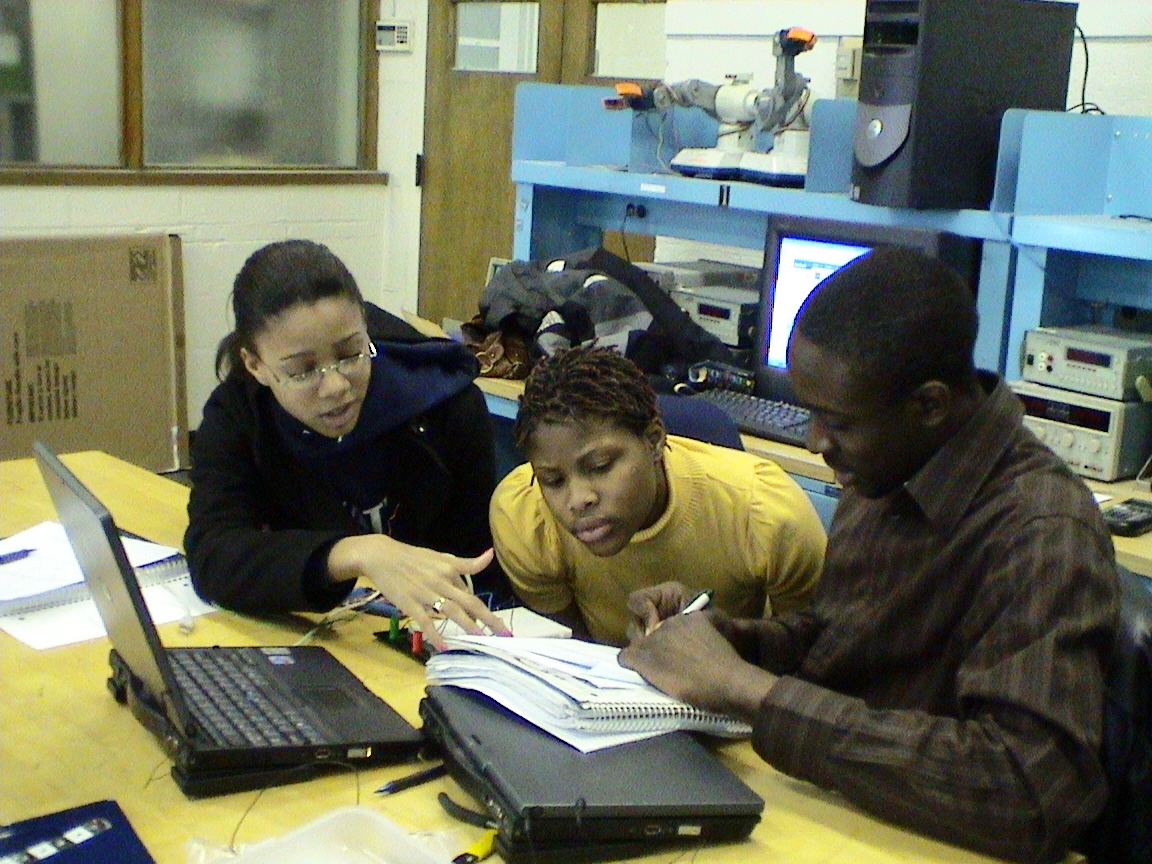
Hybrid class of EECE202 (Network I) & EECE208 (Lab)
Dr. Charles Kim
The entrance gate to ECE and the only road to Network Analysis II and Electronics I to Signal and Systems
Pre-requisite: Physics 2 (PHYS014)
Co-requisites: MATH159 (Differential Equations)
Introduction to Hybrid Class and Syllabus for Network 1 only
What is Mobile Lab ? (Link to the Mobile Lab Page)
Traditional Labs (since we cannot ignore the traditional lab setting and equipment): Tour, Lab 1, and Lab 2
Mobile Studio Lab Tutorial (with example Labs)
Chapter 1: Circuit Variables
LAB 1:
Chapter 2: Circuit Elements
KVL and KCL --Example Problems
Polarity Revisited along with KVL and KCL
LAB 2:
- (Manuals: Tek 2235 Oscilloscope, Tek CFG280 Function Generator, Tek CDM250 Digital Multi-Meter, HP 34401A Multimeter, and Tek PS280 Dual Power Supply)
LAB 3:
Chapter 3: Simple Resistive Circuits
Resistor Spec and Equivalent Resistance Example
MOBILE LAB 1:
- MS-01 Resistors and Voltage Division ( Link to Mobile Lab page)
D'Arsonval Movement and DC measurement
MOBILE LAB 2:
- MS-02 Bridge Circuit Application with CdS Cell
EXAM#1(20%): Focus of EXAM#1- (a) Understanding of polarity, passive convention, and power calculation, (b) Ability to use 3 Laws interchangeably to solve simple and complex circuit problems, (c) Ability to solve problems with dependent sources, (d) circuit simplification using series/parallel and Delat-to-Y transformation, (e) voltage divider rule and current divider rule application in circuit, and (f) Ability to solve practical electrical problems using the 3 laws.
Chapter 4: Techniques of Circuit Analysis
- Node Voltage Method
MOBILE LAB 3:
MS-03 CdS Cell Application with Comparator LM339
- Junior Yigzaw, Laurence Wilson, and D'Angelo Woods (from left) are
- testing their CdS cell circuit for LED bar charting of the illumination level.
- Node Voltage Method - Special Case
- Superposition Principle
MOBILE LAB 4:
- Thevenin Theorem
MOBILE LAB 5:
MS-05 Introduction to PSpice and PSpice Assignment (by a week after the Lab)
- Maximum Power Transfer
MOBILE LAB 6:
MS-06 Thevenin Theorem and Maximum Power Transfer

- Ashley Wells and Danah Warren (from left) scrutinize the calculation of Thevenin resistance by Oluwayemisi Sonoiki.
- Click Above to watch Don King's near-burn incident when too small a resistor is connected to the circuit, which made even stoic Marlon Mckinnie (left) gasp. The arm in front and the sound from background are Tolulope Kupoluyi's.
- Mesh Current Method
- Mesh Current Method-Special Case
- Node Method or Mesh Current?
- Source Transformation
- Summary
EXAM#2(20%): Focus of the Exam#2-- (a)The ability to use node voltage method and mesh current method in a complex circuit (30%). (b) Ability to derive Thevenin equivalent circuit and it's application to max power transfer (30%), and (c) Combined and synthetic application of node, mesh, Thevenin, source transformation in to a circuit problem (40%).
PROJECT(15%) :
- Project Description
- Peer Evaluation Form (Print, Fill out, then Hand Deliver the form. No electronic submission)
Chapter 6: Inductors and Capacitors
MOBILE LAB 7:
MS-07 RC Circuit and Time Constant and Tutorial - Transient Analysis using PSpice
- Mark Innis (right) drives the pad of the tablet PC to measure the time
- constant of the RC circuit as Sharonda Harmon wheels the variable resistor.
- Summary
Chapter 7: First-Order Circuits
Chapter 8: Second-Order Circuits
MOBILE LAB 8:
MS-08 RLC Transient Circuit Analysis
FINAL EXAM A (30%):
The following subjects will be the subject of the final exam.